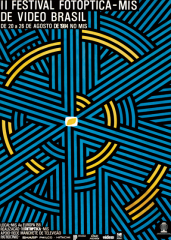- Fotoptica
- Museu da Imagem e do Som (São Paulo)
The second edition of the Festival happened during particularly turbulent times in Brazil. The country was in the process of forsaking a long-lasting military rule and building a democratic regime. Once again at Museu da Imagem e do Som (Museum of Image and Sound), the event included independent film companies such as Olhar Eletrônico, TVDO, Telecine Maruin, and Videoverso, whose innovative language attracted new audiences. The new art form began to create a link with TV. Video was trying to break into television channels, even though it seemed impossible at the time. Video art ventured to foreign lands. New art work explored the media’s technical possibilities, moving toward the creation of a language of its own. The parallel exhibition featured single-channel video screenings by international electronic art pioneer Nam June Paik, as well as installations, lectures, and a trade show for sponsors and producers. For the first time, the Festival winners participated of an itinerant exhibition, which took place in Rio de Janeiro.
Visual identity and graphic design | Kiko Farkas

Programme
competitive show
Competitive Show | 2nd Festival
Out of 120 video submissions, 60 pieces by 71 authors have been shortlisted. The five works selected as the most light-hearted won Troféu Bicho de Goiaba (the Guava Worm Trophy), awarded by Sérgio Tastaldi Studio.
film and/or video screenings
Mostra Internacional
The International Show was part of the Festival´s parallel program and presented videos from Germany, France and United States. Among those videos there were works from the pioneer Nam June Paik.
exhibition
"Caricaturas dos Tempos Eletrônicos", Rodolfo Cittadino
Rodolfo Cittadino’s exhibition featured caricatures, developed using the electronic tools of teletext, of approximately 30 Brazilian political figures.
"Ciclos", Gilson Alcântara and Rodrigo Martins Ferreira
The Ciclos video installation, by Gilson Alcântara and Rodrigo Martins Ferreira, was an environmental project focusing on the man-nature relationship.
"Nossa Senhora!", Tadeu Jungle and Walter Silveira
Tadeu Jungle and Walter Silveira’s installation was conceived as an electronic oratory with actual candles, lit to the sound of sacred and profane music. Visitors were invited to light up candles and worship Our Lady of Aparecida.
"Objeto 3-D / TVDO", Tadeu Jungle
Tadeu Jungle’s video installation was composed of a regular TV set whose image tube had been replaced with a mirror. A tribute to Nam June Paik, the founding father of video art.
"RetiranTVes", Tadeu Jungle
Tadeu Jungle’s video installation portrays migrants from Brazil’s Northeast, placing two plastic TVs on the heads of clay sculptures typical of Caruaru city.
Vide o Vídeo
The Festival program was made available for consultation on a microcomputer throughout the event.
performance
"Vídeo-Teatro: A Máscara Eletrônica", Otávio Donasci
Otávio Donasci’s Vídeo-Teatro: A Máscara Eletrônica (Video-Theater: The electronic mask) was a video performance enacted during the Festival’s opening, featuring actors wearing a TV monitor on their heads and interacting with the audience.
public programs
Debate: "Os Caminhos da TV e do Vídeo no Brasil" (session 1)
Coordinated by Cândido Mendes, the debate focused on the paths of TV and video in the country, in the light of political and economic aspects such as legislation and programming.
Debate: "Os Caminhos da TV e do Vídeo no Brasil" (session 2)
Coordinated by Gabriel Priolli, the second session of the debate on the paths of TV and video in the country focused on political and economic aspects such as legislation and programming.
Round Table: "A TV atual no Brasil - Reserva de Mercado"
The roundtable focused on the video market in the country, and covered minor and major producers and videomakers (institutional and industrial advertising).
workshop
"Psicodrama sem palavras"
A team of 14 psychodramatists conducted an experiment using live improvised instrumental and vocal music. The experiment was shown simultaneously at the auditorium and in other venues.
Video Animation
Sérgio Tastaldi, his team of assistants and Eliandro Martins gave daily presentations of computer animation during the event.
Video-Philco Workshop
During the event, a mini TV studio was set up with video cameras, lighting, and video recorders, allowing audience members to learn the rudiments of TV language.
Video-sharp Basic Course
During the seven days of the Festival, Sérgio Tastaldi taught basic video courses to children and adults.